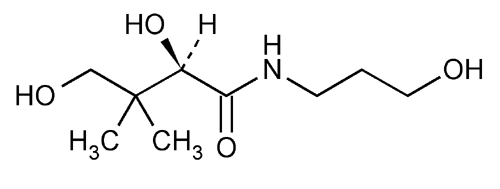Dexpanthenol
Butanamide, 2,4-dihydroxy-N-(3-hydroxypropyl)-3,3-dimethyl-, (R)-.
d-(+)-2,4-Dihydroxy-N-(3-hydroxypropyl)-3,3-dimethylbutyramide
» Dexpanthenol contains not less than 98.0 percent and not more than 102.0 percent of C9H19NO4, calculated on the anhydrous basis.
Packaging and storage—
Preserve in tight containers.
Identification—
B:
To 1 mL of a 1 in 10 solution add 5 mL of 1 N sodium hydroxide and 1 drop of cupric sulfate TS, and shake vigorously: a deep blue color develops.
C:
To 1 mL of a solution (1 in 100) add 1 mL of 1 N hydrochloric acid, and heat on a steam bath for about 30 minutes. Cool, add 100 mg of hydroxylamine hydrochloride, mix, and add 5 mL of 1 N sodium hydroxide. Allow to stand for 5 minutes, then adjust with 1 N hydrochloric acid to a pH of between 2.5 and 3.0, and add 1 drop of ferric chloride TS: a purplish red color develops.
Refractive index  831
831 :
between 1.495 and 1.502, at 20
:
between 1.495 and 1.502, at 20 .
.
Water, Method I  921
921 :
not more than 1.0%.
:
not more than 1.0%.
Residue on ignition  281
281 :
not more than 0.1%.
:
not more than 0.1%.
Limit of aminopropanol—
Transfer about 5 g, accurately weighed, to a 50-mL flask, and dissolve in 10 mL of water. Add bromothymol blue TS, and titrate with 0.1 N sulfuric acid VS to a yellow endpoint. Each mL of 0.1 N sulfuric acid is equivalent to 7.5 mg of aminopropanol. Not more than 1.0% is found.
Assay—
Potassium biphthalate solution—
Dissolve 20.42 g of potassium biphthalate in glacial acetic acid contained in a 1000-mL volumetric flask. If necessary, warm the mixture on a steam bath to achieve complete solution, observing precautions against absorption of moisture. Cool to room temperature, dilute with glacial acetic acid to volume, and mix.
Procedure—
Transfer about 400 mg of Dexpanthenol, accurately weighed, to a 300-mL flask fitted to a reflux condenser by means of a standard-taper glass joint, add 50.0 mL of 0.1 N perchloric acid VS, and reflux for 5 hours. Cool, observing precautions to prevent atmospheric moisture from entering the condenser, and rinse the condenser with glacial acetic acid, collecting the rinsings in the flask. Add 5 drops of crystal violet TS, and titrate with Potassium biphthalate solution to a blue-green endpoint. Perform a blank determination, and note the differences in volumes required. Each mL of the difference in volumes of 0.1 N perchloric acid consumed is equivalent to 20.53 mg of C9H19NO4.
Auxiliary Information—
Please check for your question in the FAQs before contacting USP.
Chromatographic Column—
| Topic/Question | Contact | Expert Committee |
| Monograph | Curtis Phinney
1-301-816-8540 |
(DSN05) Dietary Supplements - Non-Botanicals |
| Reference Standards | Lili Wang, Technical Services Scientist 1-301-816-8129 RSTech@usp.org |
USP32–NF27 Page 2096
Chromatographic columns text is not derived from, and not part of, USP 32 or NF 27.
